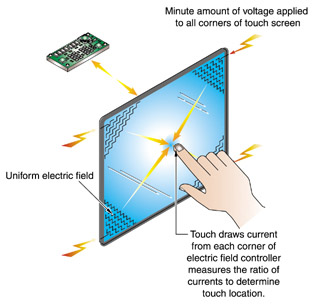TouchScreens
One of the newest methods of human-computer interaction and input is via touch screens. There are many such examples of these on the market right now, likely being bought up for the holiday season. Touch screen displays are in consumer electronics such as the HP TouchSmart line of computers, tablet notebooks, as well as the popular MP3 players from Apple and Microsoft, and a multitude of smart-phones available from various mobile carriers such as AT&T and Verizon.
Many of these touch sensitive interfaces operate of the basis of detecting changes in capacitance in the screen area. This change in capacitance happens when the user touches the screen, altering the charge. While the voltage through the screen remains the same, but the charge changes. These screens also have sensors (usually in the four corners) that can measure the change in capacitance. By determining the change in capacitance from multiple distant points (i.e. corners).

Image F: A diagram of a capacitive touchscreens.

